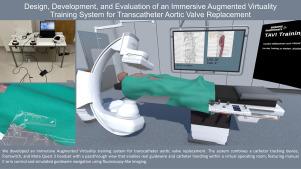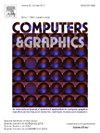经导管主动脉瓣置换术的沉浸式增强虚拟训练系统的设计、开发和评估
IF 2.8
4区 计算机科学
Q2 COMPUTER SCIENCE, SOFTWARE ENGINEERING
引用次数: 0
摘要
良好的操作技巧是进行安全有效的经导管主动脉瓣置换术(TAVR)必不可少的。传统的培训是在手术室(OR)对真正的病人进行的,需要学习新的运动技能,导致手术时间更长,并发症风险增加,患者和医务人员暴露在更大的辐射下。在介入心脏病学中,基于桌面的模拟器显示出一定的有效性,但缺乏真正的深度感知,而基于头戴式显示器的虚拟现实(VR)提供直观的3D交互,增强了训练效果和空间理解。然而,提供逼真和身临其境的训练仍然是一项具有挑战性的任务,因为两者都缺乏触觉反馈。我们开发了一种用于经股TAVR的增强虚拟(AV)培训系统,将导管跟踪装置(用于平移输入)与模拟虚拟手术室相结合。该系统使用户能够通过手动跟踪来手动控制虚拟血管造影系统,并使用类似透视镜的成像技术引导导丝穿过虚拟患者到达主动脉瓣。此外,我们对12名参与者进行了初步的用户研究,评估了晕动症、可用性、工作量、存在感和定性因素。初步结果表明,该系统为关键的程序步骤提供了真实的交互,使其成为一个适合初学者的学习工具。血管造影系统操作的限制包括缺乏触觉阻力和与c臂控制相关的可用性限制,特别是由于手部跟踪限制以及交互和监测之间的注意力分散。改进建议包括导管旋转跟踪,扩大手术覆盖范围,增强透视图像保真度。本文章由计算机程序翻译,如有差异,请以英文原文为准。

Design, development, and evaluation of an immersive augmented virtuality training system for transcatheter aortic valve replacement
Strong procedural skills are essential to perform safe and effective transcatheter aortic valve replacement (TAVR). Traditional training takes place in the operating room (OR) on real patients and requires learning new motor skills, resulting in longer procedure times, increased risk of complications, and greater radiation exposure for patients and medical personnel. Desktop-based simulators in interventional cardiology have shown some validity but lack true depth perception, whereas head-mounted display based Virtual Reality (VR) offers intuitive 3D interaction that enhances training effectiveness and spatial understanding. However, providing realistic and immersive training remains a challenging task as both lack tactile feedback. We have developed an augmented virtuality (AV) training system for transfemoral TAVR, combining a catheter tracking device (for translational input) with a simulated virtual OR. The system enables users to manually control a virtual angiography system via hand tracking and navigate a guidewire through a virtual patient up to the aortic valve using fluoroscopic-like imaging. In addition, we conducted a preliminary user study with 12 participants, assessing cybersickness, usability, workload, sense of presence, and qualitative factors. Preliminary results indicate that the system provides realistic interaction for key procedural steps, making it a suitable learning tool for novices. Limitations in angiography system operation include the lack of haptic resistance and usability limitations related to C-arm control, particularly due to hand tracking constraints and split attention between interaction and monitoring. Suggestions for improvement include catheter rotation tracking, expanded procedural coverage, and enhanced fluoroscopic image fidelity.
求助全文
通过发布文献求助,成功后即可免费获取论文全文。
去求助
来源期刊

Computers & Graphics-Uk
工程技术-计算机:软件工程
CiteScore
5.30
自引率
12.00%
发文量
173
审稿时长
38 days
期刊介绍:
Computers & Graphics is dedicated to disseminate information on research and applications of computer graphics (CG) techniques. The journal encourages articles on:
1. Research and applications of interactive computer graphics. We are particularly interested in novel interaction techniques and applications of CG to problem domains.
2. State-of-the-art papers on late-breaking, cutting-edge research on CG.
3. Information on innovative uses of graphics principles and technologies.
4. Tutorial papers on both teaching CG principles and innovative uses of CG in education.
 求助内容:
求助内容: 应助结果提醒方式:
应助结果提醒方式:


